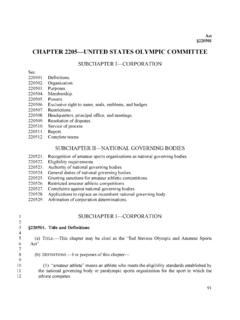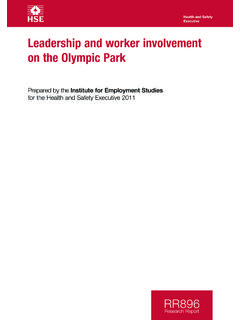Transcription of London Olympic and Paralympic Games 2012 - Intervention ...
1 London Olympic and Paralympic Games 2012 HSE Construction Division Intervention Strategy and delivery arrangements for regulating the Construction Phase of the London 2012 Venues and Infrastructure 1 INTRODUCTION Scope 1 This Strategy covers construction projects on the Olympic Park, the Athletes Village and other sites related to London 2012 where the Olympic Development Authority (ODA)/CLM or the London Organising Committee of the Olympic Games (LOCOG) is the construction client or is closely involved. The construction work will include fit out of London 2012 venues by others, for example, the Olympic Broadcasting Service, and LOCOG construction overlay of new and existing venues.
2 Annex 1 describes the key organisations involved. The strategy takes account of the ODA s Health, Safety and Environment Standard which is published on the ODA website. 2 The main venues for the London Olympic and Paralympic Games will be in the Olympic Park in Stratford, East London . The site extends over 500 acres of formerly mixed-use land- both industrial, residential and brown field sites; much of the land was contaminated from its former industrial uses. The land is in the lower Lea Valley and the Park (roughly the size of Hyde Park) and contains a number of natural and artificial waterways which have now been opened up to become a prominent feature of the Park itself.
3 There are other venues outside the Olympic Park that will need significant construction work to get them ready for the Games . 3 By July 2010, almost all the enabling works has been completed and the big build of the main venues on the Olympic Park is more than 60% complete. Fit out of the venues is starting on some of the sites. ODA/CLM is more closely involved with the building of the Athletes Village, and this project now has seven separate principal contractors. The big build will be completed in the first half of 2011 and venues will be progressively handed over.
4 Later in 2011, LOCOG is due to commence Games overlay construction work in Olympic Park venues and the erection of temporary venues such as the equestrian centre at Greenwich Park. Most of the venues and the Athletes village have legacy uses which will involve further construction work after the Games have been staged. Some of the venues will be dismantled and erected elsewhere in the country. Venues such as the Olympic Stadium and the Aquatic Centre are designed so that they can be converted to smaller facilities for legacy use. 4 Stratford City is a major shopping/business development which lies between Stratford International station and Stratford Regional Station, immediately adjacent to the Olympic Park.
5 That project is not covered by this strategy. 5 The ODA has a responsibility under section 10(2) of the London Olympic Games and Paralympic Games Act 2006 for an Olympic Transport Plan in order to ensure that transport to and from the Games is sufficient. ODA is therefore providing grant-aid to help ensure that vital transport infrastructure projects being undertaken by TfL, LUL, DLR and Network Rail are completed in time and to the necessary scale and quality for the 2012 Games ( the Stratford Regional Station upgrade and new sections of track, stations and platform extensions for DLR); The ODA is not the construction client for these projects, and they are not covered by this Intervention strategy.
6 6 This is the third version of the HSE Construction Division s Intervention strategy covering construction work. 2 CONSTRUCTION DIVISION Intervention STRATEGY AND DELIVERY ARRANGEMENTS Strategy 7 The goal for HSE s regulatory work is to satisfy ourselves that duty holders are achieving high standards of health and safety compliance throughout the design and construction phases of the venues and infrastructure for the Games . We will make sure that proper consideration is given to the risks arising from the use and maintenance of structures, and from the need to modify or dismantle them in legacy mode.
7 In particular, we will be seeking: Strong leadership from the ODA, LOCOG and others in the supply chain in championing the importance of, and a common sense approach to, health and safety; A clear commitment to ensuring and developing the competence of all workers involved in the construction of the Games venues; An active promotion of the value and benefits arising from worker involvement in the management of health and safety on site. 8 Our strategy is based on the principles of effective inspection and enforcement set out in the Hampton Report of 2005. In implementing the strategy we will ensure that we: make best use of Construction Division s limited resource; carry out timely and proportionate interventions to promote compliance, targeting higher risk activities and challenging inadequate arrangements; promote a consistency of approach with colleagues and other Regulators to avoid duplication.
8 9 We are committed to ensuring that lessons learned and good health and safety practice developed during the construction of the Games venues will be shared across the whole industry. The goal is to contribute to the lasting legacy from the Olympic project in line with the stated objective of the Coalition Government s Programme (Ch. 7). See also para 18. Progress to date 10 Our approach to date has been to engage early with construction clients in order to satisfy ourselves that they have adequate arrangements for ensuring that projects are properly managed. We have intervened with selected projects to: check that there are suitable processes for identifying and eliminating risks during the design stage (including use, maintenance and legacy), or reduce such risks to an acceptable level before the main construction work starts; visit projects early in the construction phase to check that the principal contractor s basic site arrangements (including transport plan, site security, induction and worker engagement) are to a high standard.
9 Discuss the intended controls for higher risk work activities with the relevant specialist contractors - normally we will seek a presentation; carry out sample follow up inspections to check that systems of work match those described, that HSE priority topics (such as workplace transport) are being managed and arrangements for controlling interfaces with neighbouring sites are working properly. 11 While the main phase of big build is now well advanced, some construction projects have yet to start, for example some temporary venues and Olympic Overlay construction. We have not intervened with all principal contractors responsible for Olympic venues and infrastructure projects- we have assessed the need to intervene depending on the scale and nature of the work planned, the consequent risks and Construction Division priorities.
10 Occasional site visits have been made to 3 work areas not selected for planned interventions to assess the nature of the risks and ensure they are being properly controlled. Proactive Interventions 12 The construction team of inspectors covering NE London (FMU 86) will continue to undertake interventions with ODA/CLM in order to maintain high standards of client management for all projects and for cross-Park issues (for example the allocation of areas in the Olympic Park between Tier 1 contractors and the management of interfaces). We will also continue to work with the LOCOG Venues and Infrastructure team to clarify their role and proposed arrangements for the design and construction of temporary venues and installation of Olympic Overlay.


















